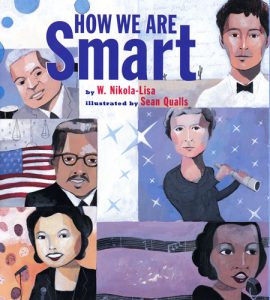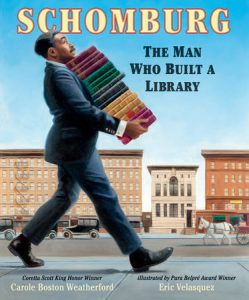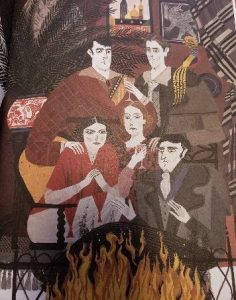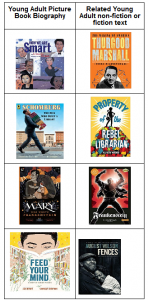by Karen Matis with Charlene Klassen Endrizzi
As collaborators in our work with secondary education preservice teachers each fall, we offer a month long look at picture book biographies filled with stories of courageous, determined global citizens that will especially appeal to adolescents.
The selected biographies we share present “Hidden Stories” of diverse writers, historical figures, mathematicians and scientists, all courageous activists who tackled their own set of problems in by-gone years. Our goal focuses on offering inspirational moments through relevant texts, thus revealing spirited advocates for change.
The past year brought unrest into the lives of many adolescents. In the midst of their naturally occurring coming of age insecurities, young people also endured circumstances resulting from health, social justice and political uncertainties. Such upheaval creates openings for middle school teachers to pause and ponder much needed moments of inspiration. We invite you to our discussion of inspiring picture books that encourage adolescents to consider their own lives in juxtaposition to others who also faced uncertainties in their lives.
“I’m not smart,” is a comment overheard frequently in middle school classrooms. When students struggle with a concept, this escape phrase can quickly become a ticket for giving up. When I (Karen) entered junior high school, I struggled with math which led me to believe that I wasn’t smart. Language arts came easy for me, but it wasn’t until high school when I began to realize this was one of my cognitive strengths. Years later when I overheard this comment in my classroom, a response I offered my doubting middle school students was, “What does it mean to be smart?” When students begin to understand there are different ways of knowing, they develop healthier attitudes towards the role intellectual diversity plays in their life.
“Biographies encourage students to become curious about various time periods, consider difficult or sensitive events, and become involved in discussions of diversity and social justice” (Chick, 2011). This genre can help students understand the variety of ways humans are smart and the extent that intellectual diversity guided successes in famous hidden legends’ lives. How We Are Smart (Nikola-Lisa, 2009) shows twelve global citizens using multiple literacies in their professional lives. This picturebook incorporates poetry and colorful illustrations to provide visual appeal. Each category of “smart” is featured at least once. Students might conduct a human intelligence smart activity where they interview and categorize other students, family members, friends, and even famous people based on multiple intelligences. For example, some learners might categorize Taylor Swift as “music smart”. Others who know Swift writes the lyrics to many of her hits might argue that she’s “word smart”. Fortunately, there’s room for her in both of these intelligence categories, and adolescents soon begin to recognize the ability to “fit” into more than one.
We first offered the How We Are Smart picture book biography as one choice during a Family Book Club evening last year with Karen’s middle school students and parents. Their keen interest in Smart led us to brainstorm ways to use picture book biographies with our preservice secondary education students. Through bi-weekly Learning Invitations, students embraced the opportunity to connect often unknown legends with disciplinary concepts to initiate engaging lessons. One preservice teacher, Hope, offered a graphic to assist adolescent students in identifying the different ways individuals are smart. Hope’s insight into her learners’ needs helps her students connect people and intelligence strengths using a visual format (How we are smart PosterMyWall.mov).
Another ELA preservice student selected the picturebook biography Schomburg: The Man Who Built a Library (Weatherford, 2019) as a subtle way to begin respectful classroom discussions surrounding race and culture. Schomburg queried, “Where is our historian to teach our people our own history?” Born and raised in Puerto Rico, this change agent moved to New York City in his teens and began his lifelong passion of collecting both art and literature representing his African American and Puerto Rican cultures. The collection, which includes more than ten million pieces, is housed in the Harlem library named after its collector. It can be visited online at Digital Schomburg.
“A book is like a garden carried in a pocket,” is a fitting epitaph offered by Linda Lui, the author of Schomburg. The Schomburg Learning Invitation, launched with a visual image of a library, capitalized on Lui’s proverb by challenging middle school learners to share books they carry in their “pockets” and to discover multiple cultures represented within their personal libraries.
Liana, another ELA preservice teacher, understands that to improve language skills, students must continually explore multimodal tools. Her Learning Invitation includes reading author Linda Bailey’s biography picturebook Mary Who Wrote Frankenstein (Bailey, 2018) and encouraging students to draft opening lines for a “scary” story. Bailey captured Mary Shelley’s early years as well as the challenges she faced in writing a horror story. The illustrator, Julia Sarda, incorporates dark colors and lines in the illustrations enhancing a somber mood.
At a time when women were kept “hidden” and discouraged from becoming authors, Shelley capitalized on the opportunity to write. Her success as a writer begins a spirit of change in the public’s view of women authors. For adolescents who struggle with the writing process, Shelley’s picture book biography is a welcome resource. Shelley used current scientific news about the discovery of electricity to spark her imagination for writing Frankenstein, claiming she “found her ghost story!” As a starting point, ELA learners can be asked, “What new technological, environmental, scientific… discoveries in the world today might inspire the opening for your ghost story?”
Liana also explored the biography Feed Your Mind: A Story of August Wilson (Bryant, 2019). Facing racial prejudice growing up in Pittsburgh’s Hill District, Wilson persevered writing about the people in his neighborhood. He was a listener first and then a writer, capturing the essence of the streets in Pittsburgh. Liana quickly focused on Wilson’s mother’s words to him, “If you can read, you can do anything–you can be anything.” This biography is written in Two Acts and features a mix of prose, poetry, and drama, as colorful as its’ telling of Wilson’s life. A strong message of resiliency, persistence, and overcoming challenges, Wilson’s life depicts deviation from intellectual norms. The addition of this biography to a middle school library is one that won’t sit on the shelf for long.
Over the semester, picturebook biographies offered Hope, Liana and other preservice teachers inspirational hidden stories to launch English units of study. The book pairs displayed below (picture books matched with novels or non-fiction texts) can jumpstart ELA teachers’ inquiry into hidden stories of courageous change agents.
References
Chick, K.A. (2011). Picture book biographies: Fostering active student involvement in women’s history month. Social Studies Research and Practice, 6(2), 69-84.
http://www.socstrpr.org/wp-content/uploads/2011/09/chick.pdf
Journey through Worlds of Words during our open reading hours: Monday-Friday, 9 a.m. to 5 p.m. and Saturday, 9 a.m. to 1 p.m. To view our complete offerings of WOW Currents, please visit its archival stream.
- Themes: Charlene Klassen Endrizzi, How We Are Smart, Karen Matis, W. Nikola-Lisa
- Descriptors: Books & Resources, WOW Currents






Biographies can be a great tool to see something from somebody else’s perspective. This is needed now more than ever.
Great resources! I will be sharing with middle school teacher friends. Thank you for doing this!
The resources compiled here could not be more relevant and valuable. I’m looking forwarding to including a couple of these works into my curriculum…especially the August Wilson biography. Thank you!
The resources compiled here could not be more relevant and valuable. I’m looking forward to including a couple of these works in my curriculum…especially the August Wilson biography. Thank you!
Thanks for encouraging comments! Charlene and I have discovered a current trend in young adult picture books that feature hidden legends and not-so-hidden legends. It’s our hope that educators will embrace using these resources as yet another tool in their toolbox for engaging and motivating young learners. To that end, Charlene’s preservice educators are engaged in creating Learning Invitations using these materials that are student-friendly and easily accessible to middle and high school students.
These powerful stories touch the mind and the heart. To deepen connections in my middle school classroom, I asked students to take the Intelligences Quiz (Howard Gardner, 1983) to help them identify their own hidden stories, their own ways of being smart. This personal exploration brought animated small group discussions that lasted beyond the classroom experience. Even family members responded!
I haven’t heard of YA Picture Books before reading this. Makes perfect sense. Schomburg: The Man Who Built The Library is a fascinating story that is a part of my library. Looking forward to checking out the others on the list. Another resource that may be of interest is https://www.readacrossamerica.org/ The site is a celebration of diverse readers with book selections for educators.
Thank you for your continued work and investment in the future of our youth.
I love the way these “hidden stories” were elevated and given space to be explored. It’s especially important to surround students with relevant texts that allow them to make sense of who they are and who they want to be. I appreciate the way you leaned into the present moment (2020-2021) to use texts as the vehicle through which students explore big ideas such as resiliency, perserverance, courage, etc. Thanks for introducing me to some new texts and the ways they can be paired together!